One of the side effects of today’s cyber security landscape is
the overwhelming volume of data security teams must aggregate and
parse. Lean security teams don’t have it any easier, and the
problem is compounded if they must do it manually. Data and log
management are essential for organizations to gain real-time
transparency and visibility into security events.
XDR provider Cynet has offered up a new guide (read it here[1]) that helps lean
organizations understand the importance of centralized log
management (CLM). The truth is that even the most well-stocked and
staffed teams would have trouble manually handling their log
management needs, which is why organizations are increasingly going
the automated route.
On top of the efficiency of automation, CLM gives organizations
much greater visibility into their environment and security events
that impact them. However, the benefits of deploying CLM tools and
reducing the level of human intervention in log management and
analysis are much more than just reducing work hours.
Why CLM is critical for lean security teams
Logs are a natural part of IT management. Each time-stamped
event record collected in a log is an important piece of the
overall puzzle that is an organization’s security operation. This
data can be a trail of breadcrumbs and indicators of compromise,
which shows security teams what attackers are doing and attempting
to do. However, when these logs are incomplete, improperly sorted,
or simply not parsed, the picture becomes murkier and harder to
glean.
CLM tools can help combat this lack of transparency in several
ways. First, when there are more data points and logs that can be
easily accessed and analyzed, organizations can build significantly
better reconstructions of security incidents, different attack
attempts, and breaches. Additionally, it helps for the future, as
organizations can become better at detecting false positives and
negatives, as well as missed detections. Finally, it reduces
fatigue and wasted time, letting security teams focus on other key
areas.
The new guide focuses on these topics, breaking down:
- The importance of accessing and analyzing log
data. As mentioned above, simply having easy access to
this data makes organizations better at detecting attacks and
understanding previous incidents. More importantly, how data is
stored also makes a difference, with data lakes a clear
favorite. - The four main approaches used to gain centralized log
management. Organizations can take a few different paths
to improving their log management capabilities, and each comes with
its own benefits and drawbacks. Understanding which path to take
can help organizations make smarter decisions. - Why CLM is critical for security teams’ success.
Log management is all about adding greater transparency
into an organization’s security events, and handling it manually
means organizations might lose out on a lot of key insights. CLM
ensures this is not the case. - The key benefits of a CLM solution. Building a
CLM system from scratch is complex and not always feasible.
Moreover, adding expensive tools that include advanced services and
features just for CLM functionality isn’t worth it. A CLM solution
is an excellent middle ground. CLM also assists with meeting
regulatory compliance requirements, automating reports, and
managing policy changes.
Learn more about how lean security teams can benefit from CLM
here[2].
References
- ^
read it
here (go.cynet.com) - ^
how lean
security teams can benefit from CLM here
(go.cynet.com)
Read more http://feedproxy.google.com/~r/TheHackersNews/~3/HSypHq8jDo0/ebook-guide-to-centralized-log.html
